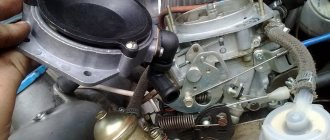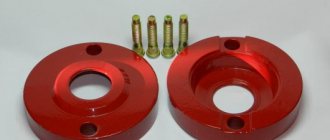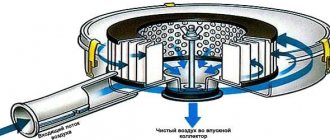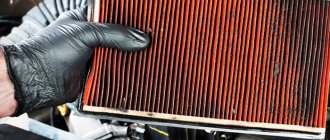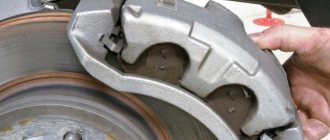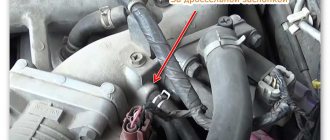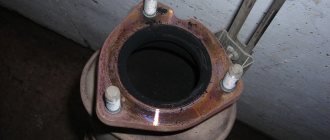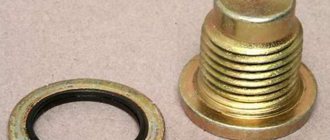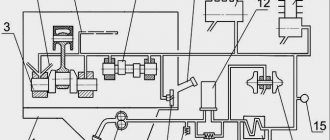Almost all car enthusiasts have a desire to increase the power and dynamics of their car. At the same time, everyone uses their own methods, based on capabilities and level of knowledge.
Some optimize the engine, others install various body kits and spoilers, others use high-quality consumables, and so on.
But experienced car owners know about another popular method - installing a zero-resistance filter.
So what is this device? What are the differences between “nulevik” and standard filters? Is there any point in spending money? Let's figure it out.
What is a zero resistance filter for and where is it used?
The task of the air filter installed in each car is to clean the flows entering the engine from various “garbage”. But this is a double-edged sword.
On the one hand, installing a filter allows you to clean the air, and on the other hand, it creates additional resistance to the flow.
The result is a decrease in power, which is especially noticeable as the filter element becomes dirty.
Zero resistance filter is an alternative to the classic filter. The main purpose is to reduce the overall air resistance without compromising the quality of cleaning.
It is believed that installing such a filter can increase engine power by an average of 5-7%. At the same time, there is almost no way to feel the difference from installation. All that remains are facts that you have to believe.
“Nuleviki” are actively used on sports cars with the same purpose - to add power to the power unit. At the same time, any alternatives are not even considered.
But it is worth considering that the difference between sports cars is not only in the installation of a special filter, but also in a more advanced exhaust system, which allows the release of large volumes of exhaust gases even at maximum speed.
Benefits of a zero resistance filter
The reduced resistance of the filter device corresponds to an increase in air flow speed, and therefore causes an increase in the cylinder fill factor. And strangely enough, this fully corresponds to reality. You will have the opportunity to replace the standard unit and install a filter of the type discussed in the article to obtain a noticeable increase in power. The engine will start without problems, and the car will accelerate briskly, but on the condition that the power unit is single-cylinder and designed for operation at a constant speed, for example, in pump drives.
A typical four-cylinder car engine is not suitable for a zero-resistance filter. As proof, car manufacturers would have long since started equipping their engines with this variety. This raises a logical question: why is a total air intake used for each of the cylinders? The fact is that this solution is much simpler and cheaper to produce and, importantly, each cylinder receives a uniquely homogeneous air-fuel mixture, which makes it possible to forget about a number of obstacles associated with alignment.
The main difficulties lie not in the operating process or in the resistance of the filter, but in the correct setting of the air inlet device. Due to the use of one intake pipe to provide air to each of the four cylinders, air flows unevenly through the intake manifold, creating turbulence and waves.
When removing the filter element from the vehicle, there is a chance that you will notice faster engine operation, but only in one narrow rev range. As a rule, at idle speed or slightly higher - thousands of revolutions per minute. Mostly if the filter solution was heavily contaminated. However, after a certain number of weeks, the contaminants will move to the oil sump and compression rings, sharply increasing the consumption of contaminated oil due to the poor performance of the compression rings.
How is it different from other types of filters?
The main difference between the “nulevik” lies in its design. Classic filters installed on most cars are made of paper (more precisely, from compressed fibers).
The flow of air masses passes through small holes in the fibers, and then goes to the motor.
As soon as the fibers become clogged, the resistance also increases, because the air needs to find new ways to overcome the obstacle. If you do nothing, the engine power drops.
Taking into account existing standards, the paper filter must have a large thickness with maximum fiber compression. This design ensures high-quality cleaning, but the resistance is increased immediately after installation.
The design of the “nulevik” is based on the principle of reducing resistance.
The device is based on several layers of cotton, which effectively traps dust and dirt. In this case, the retained particles essentially become part of the product.
Thanks to this, the efficiency of the filter element is higher and one square centimeter of surface accepts more dust than its predecessor.
Cotton fabric is sandwiched in an aluminum screen, which increases the filter surface. The developers claim that the working part of the “nulevik” is 4-5 times larger than in a classic filter, which ensures a long service life and lower resistance of the product.
This is achieved thanks to another factor - the presence of a special coating (oil) on the cotton, which traps dirt without harming the flow.
K&N filter
The products of this manufacturer have firmly established themselves in the automotive market and have a huge number of admirers.
The K&N zero resistance filter was developed in California by the company of the same name to help increase power values. In terms of their characteristics, the products of this manufacturer are in many ways ahead of their analogues from competitive companies. According to the developers, installing it on the engine will increase power figures by as many as four “horses”. The element can be used for a long time, and when operating a car in normal urban conditions, it can be cleaned only after 80 thousand km of the car's mileage.
The K&N Zero Resistance Air Filter is made from the purest cotton.
The main parts of the element consist of several cotton layers, which are located between two aluminum plates. To increase the performance of the filter, it is impregnated with special oil, and its design features ensure durable and reliable operation on any engine.
All products from this manufacturer have a warranty period, which, according to the company's engineers, is one million miles.
The principle of operation of the filter, its features
The operating principle of the “nulevik” is based on two factors:
- high-quality cleaning of the flow entering the motor;
- minimum air resistance.
The effectiveness of the zero resistance filter is due to its unique design and the use of cotton (rather than paper) material.
The incoming flow is filtered from dust without causing any significant contamination to the product. Thanks to special impregnation, particles entering through the filter settle on the surface and do not interfere with the flow of air to the combustion chamber.
As a result, a sufficient volume of air enters the intake manifold, and the power of the power unit increases.
Operating the filter on vehicles with an internal combustion engine
This design feature of the filter, as an option, is effectively used in engines that use the method of pumping air through a gas turbine. As an example, a filter with zero resistance goes well with a diesel engine equipped with a turbine.
The air compressing device is very sensitive to vibrations and other disturbances in the air flow at the inlet. To ensure stability of the turbine operating process, air flows must be thoroughly cleaned of dust and protected from unwanted disturbances by a special guide-type apparatus. In this situation, zero type resistance is very necessary.
Advantages and disadvantages of “nuleviks”
As practice shows, such filters have their positive and negative qualities.
Let's start with the pros:
- increase in power by 5-7%. Of course, this may not be noticeable to the driver, but when installed in combination with other types of engine tuning, the result can be felt for yourself;
- changing the sound characteristics of the motor. It is believed that the filter element makes a special sound, which changes the general hum from the engine compartment. Many car enthusiasts install “nuleviks” precisely for this reason;
- The appearance of the space under the hood changes - it becomes more sporty.
Disadvantages of "nulevik":
- the need for constant maintenance, which not all car owners like to do;
- affordable filters are of low quality, so they clog almost immediately. The oil also becomes contaminated faster, which leads to a decrease in the life of the power unit.
How to care for such filters?
As already mentioned, one of the main disadvantages of the filter is the need for regular maintenance.
After purchasing and installing the product, it must be washed and treated regularly. In this case, processing according to the “remove-wash-install” principle will no longer work - a special algorithm is required here.
The frequency of washing is every 5-6 thousand kilometers. If the car is operated in dusty areas or off-road, then the filter must be cleaned more often.
If you forget about servicing the device, the machine becomes “gluttonous” and “dumb.”
The algorithm of actions is as follows:
- remove the zero filter from the machine and remove all dust from it using a special brush;
- Wash the unit in a special container with a special cleaning solution, then rinse the filter under water pressure;
- shake off the filter element and inspect it. If there are light spots, the filter needs to be impregnated with a special agent;
- treat the product with a special impregnation (as a rule, it is sold separately from the “nulevik”);
- return the “zero” to its original place.
There are even special kits for caring for “nuleviks”, which include washing and impregnation. A few manipulations as described above, and the product looks like new.
Please note that the total number of washes can be limited and is about 20 pieces. After this, it is worth installing a new filter.
Installation Features
Many car enthusiasts make a big mistake - they install the “zero” incorrectly, which is why it is not able to perform its functions normally.
For example, the filter is installed too close to a hot engine or exhaust manifold. Here it’s time to remember physics.
The density of cold air is higher than that of hot air. As a result, it is easier to “push” cold air into the combustion chamber than hot air.
Therefore, the “nulevik” should be located as far as possible from any heat sources (motor, exhaust manifold, etc.).
In addition, it is not recommended to install the filter in the lower part of the engine compartment. In such a situation, the product will quickly become dirty and lose its best qualities.
In addition, a dirty filter will have to be “repaired”, which will also take some time.
Today there are a lot of models of zero filters that are designed for installation on various types of cars - with an injector or a carburetor.
The material can be mesh, foam rubber or cotton. Filters made of foam rubber have the highest degree of purification, but they also have more resistance than their “brothers”.
Installation of the “nulevik” on different cars is done differently, but in general you need to follow the following algorithm:
- discard the connector from the MAF (mass fuel flow sensor);
- use a screwdriver to disconnect the rubber tube from the air flow sensor;
- remove the sensor fasteners from the body (to do this you will have to unscrew a couple of bolts);
- dismantle the case and remove the rubber clamps (use duckbills or pliers);
- unscrew the fastener from the group of wires;
- fasten a pair of bolts from the mass air flow sensor clamp to the “zero” fastener;
- Place a new filter on the mass air flow sensor, tighten the clamping clamp and connect the sensor.
That's all, the new filter is installed on the car.
Pros and cons of zero
Having familiarized yourself with the design and differences between the factory paper filter and the zero filter, you can confidently name the advantages of the second:
- Thanks to its complex design, the nulevik provides low resistance without compromising cleaning quality, protecting the intake system from debris and the engine from wear.
- The fabric configuration allows you not to change the filter every 10 thousand km. It is enough to simply renew the impregnation and rinse the element.
- After replacing the unit, the motorist will receive several additional horsepower. More likely, there will be an increase in torque at mid and low speeds.
However, like any upgrade, tuning the power unit using a modern filter also has its drawbacks:
- To obtain an actual increase in torque, you will have to perform several additional operations: remove the standard element along with the liner and install a cone zero on the mass flow sensor or on its pipe.
- It makes no sense to install a filter on an engine with a volume of up to 1.8–2 liters. The increase in power will be no more than 5 horsepower, and physically even the most experienced driver will not be able to feel it.
The engine displacement indicator can be neglected if a comprehensive modification is carried out: installing sports camshafts and boring the cylinders. To increase the efficiency of the intake system, together with the zero valve, an enlarged throttle valve is purchased.
How to make a zero filter with your own hands?
Some car enthusiasts, in a desire to save money, decide to make a “nulevik” with their own hands.
The source is a factory round filter, which was once installed on Moskvich cars.
To make a “nulevik” you can use different methods. We will describe one of them below.
You will need available tools (foam rubber, sealant, sharp knife, glue and others). The total price of the issue is no more than 3-4 US dollars.
It’s worth noting right away that a converted “zero” is unlikely to add power to your car. The reason is outdated technologies that were used in the production of cars in the 70-80s.
When creating filters, manufacturers thought little about the importance of cleaning, so old products only retain very large pieces of dirt. So, by “creating” a zero filter, you are taking a certain risk and can “kill” your engine.
By the way, the only car where such a zero filter would be “at home” is the Moskvich. At the same time, there are owners who immediately cut off the walls to eliminate excess flow resistance.
If you decide to experiment, the sequence will be as follows:
- remove the standard device;
- Make a rectangular adapter with a hole from a piece of plywood.
Drill four more holes and fix the adapter to the air meter sensor.
Before doing this, install a piece of pipe into the hole and treat the cracks with sealant;
- Make additional holes in two plywood circles. At the same time, make a hole of a larger diameter on the outer circle, and on the inner circle (installed near the air meter) - according to the diameter of the pipe being installed. The latter shrinks using sealant;
- make 3 bars with a length of about 16-18 centimeters and use them to fasten the circles. The result will be a unique cylindrical shape. Since there is no plywood in the bars, it is necessary to make holes along the edges for installing self-tapping screws (otherwise the plywood may be damaged);
- To prevent the foam from falling out, make a body. To make it, you can take a mesh for GVL joints. The advantage is the presence of a sticky base, which allows for immediate fixation;
- then foam rubber is glued on the outside using thermosealant, which allows you to securely and quickly fix the device;
- fix a couple of pieces of foam rubber for the side of the barrel with sealant;
- put on foam rubber and fasten the plywood beams with ties.
There are simpler solutions.
Reviews
The best indicator of the need to install such a device is reviews from real car enthusiasts. Here are some of them:
Anton, Belgorod.
“I’ve been driving with a zero car for a long time. I did the intake and exhaust at the same time, so the result was significant (like after a good engine chipping). If you install a zero filter on a regular car with normal settings, there will be no result.”
Egor, Kazan.
“I didn’t feel any effect from installing a zero filter. What can be changed by installing a piece of rag?!”
Mikhail, Smolensk.
“When you turn off the engine, there is a unique suction sound that adds to the “sportiness” of the car. I installed a “zero” on the Galant and am pleased. The car felt faster.”
